Executive Summary:
- Saved more than $46,000 on a recent project.
- Multi-process capabilities benefit pipe fitters, ironworkers and boilermakers.
- Reduces welding costs by decreasing the number of engine drives and associated upkeep costs.
- Increases operator efficiency with easy-to-use, familiar equipment.
- Situating equipment on skids and racks eliminates jobsite clutter.
Contractor Saves 40 Percent on Equipment Rental By Pairing Inverters With Welding Generators
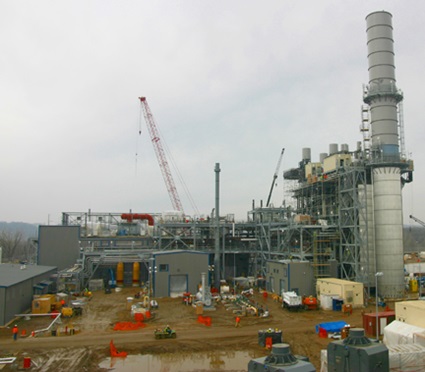 |
| A typical job for AZCO, Calpine Corporation’s Mankato, Minn., power plant site benefits from Mike Lang’s simplification philosophy and nine PipePro/XMT 304 skids, which are used throughout.
|
Simplification is a key concept for Mike Lang, tool/warehouse manager for AZCO INC. of Appleton, Wis. On any given day, 400 to 500 AZCO INC. employees are busy at construction sites around the country, erecting power plants, foundries and a variety of other facilities. Lang has the daunting task of making sure that pipe fitters, ironworkers and boilermakers—all of whom may have different arc preferences, rely on different welding processes and use different types of electrodes—have the equipment they need to do their jobs effectively. He also has to manage a fleet of more than 300 welding power sources cost efficiently.
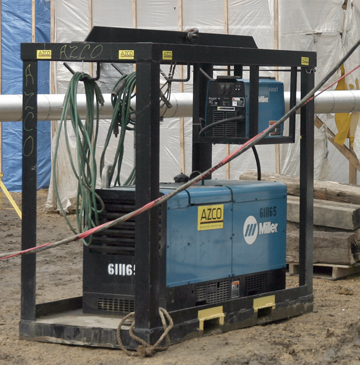 |
FIG. 1. AZCO’s ubiquitous PipePro 304/XMT 304 skids meet the welding needs of pipe fitters, boilermakers and ironworkers while decreasing maintenance and rental costs.
|
Fortunately, one key “tool” in Lang’s warehouse are skids (see Fig. 1) that pair an XMT 304 inverter and PipePro 304 diesel welding generator from Miller Electric Mfg. Co. AZCO’s self-designed skids can pair these welders because of the PipePro 304’s unique capability: it produces 7,500 watts of generator power while welding at 200 amps. This means it has enough generator power to run an XMT 304 that is also welding at 200 amps or less, so two operators can work simultaneously off of the same skid—and without any interference between the arcs.
On a job site that would normally require two individual engine drives to meet welding needs, AZCO’s skid reduces equipment costs by more than 40 percent. In fact, using nine inverter/welding generator skids saved AZCO more than $46,000 on a recent project. In addition, because the inverter-based XMT 304 and PipePro 304 set the standard for multiprocess arc quality, Lang satisfied the needs of all the skilled welding trades on the project.
Versatile Yet Simple
AZCO is an integrated construction company that prides itself on its limited reliance on subcontractors. It operates its own pipe and metal fabrication facilities, and it maintains the expert staff needed to see projects through from design through completion. The diversity and magnitude of its operations present many challenges, especially when it comes to equipping its many welding operators working across the nation. A power plant provides a good example.
A power plant may start with a bare field where pipe fitters come in to weld the underground cooling water piping, which will typically be of mild steel. For this process, they’ll likely use Stick welding, or a combination of Stick and flux cored welding. Next the ironworkers will come in and use a combination of Stick and flux cored welding to erect the structural steel—but they may want different arc characteristics. Once the steel structure is in place, the boilermakers will weld the stainless steel boiler tubing using a combination of DC TIG and Stick welding. Finally, the pipe fitters will come back in and use a combination of DC TIG, Stick welding and flux cored welding (and different electrodes, such as cored stainless steel wire) to weld the high-pressure steam lines and other pipe associated with a steam turbine, which is often made from 9Cr-1Mo-V (P91) or 2-1/4Cr-1Mo (P22) steel.
“The pipe fitters are particularly demanding when it comes to Stick arc quality,” says Lang. “There are some models of welders that they simply don’t like to use. Conversely, the boilermakers need a good TIG arc, while the ironworkers want a welder with enough power to run .045-in. flux cored wire at high output. Fortunately, the multiprocess CC/CV output of the XMT 304 and PipePro 304 meet everyone’s needs.”
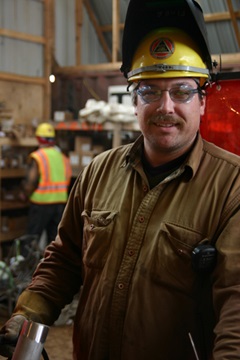 |
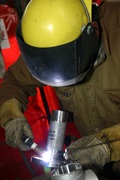
“With the XMT 304, you can control the puddle much better and your tungsten lasts longer,” according to Scott Flora, a pipe fitter with AZCO.
|
Miller Electric’s XMT 304 CC/CV is an inverter-based multiprocess welder with a 5- to 400-amp output—and so is the PipePro 304. In fact, the PipePro 304 is essentially an XMT 304 powered by a 3-cylinder, 26 HP Kubota diesel engine. The process selector switch, Dig/inductance and volt/amp controls are even the same.
“All the skilled trades have to take a weld test to qualify for welding on every job site,” explains Lang. “Some people might not pass the test, but it won’t be because of the equipment. Many of the union training centers train on the XMT 304 and the PipePro 304 because they provide excellent arc quality, and because they’re really easy to set up.”
As another plus, if an operator is familiar with setting up an XMT 304, they can set up a PipePro 304 without a problem, and vice versa, because of the common controls.
Dennis Marten, an AZCO piping site-superintendent working on a power plant in Mankato, Minn., confirms Lang’s assessment.
“All of our operators test on the XMT 304,” said Marten. “Most people prefer the XMT 304 because of its ease-of-use. Its LCD shows all the welding parameters, and there’s just one process control. It’s a pretty easy machine to use and for a welder to produce a quality weld. They just flip the power switch, turn a knob and they’re ready to start welding.”
Marten notes that easy-to-use welding machines also make it easier to find qualified welders.
“A job like the Mankato project can easily use up all of the qualified welders in an area, so people from across the country come in for this job,” he says. “Familiarity with equipment is important, because if welders can set up quickly and pass the test easily, they can go to work more quickly.”
Generator Power to Spare
The PipePro 304 produces12,000 watts, 1- or 3-phase generator power.
“When we first saw the PipePro 304 and realized how much generator power it had, Jim Hennessy, a former AZCO technical supervisor, and I decided to conduct an experiment,” says Lang.” We plugged an XMT 304 into the PipePro 304’s 230V receptacle, got two guys Stick welding while we manned the controls and said, ‘let’s see how far we can crank them up.’ Eventually, we found that we could weld up to 200 amps before either the inverter or the engine drive’s arc would become erratic. Jim said ‘we’re well past the welding parameters for our Stick and TIG welding procedures,’ so we knew the PipePro 304/XMT 304 combination would work.”
Skid Savvy
After about a year of experience with using trailer-mounted PipePro 304s, Lang decided to try something different.
At first, Lang planned to build a skid from angle iron and mount the PipePro 304 on the skid. The skid would have fork pockets for moving it around the job site with a small rough terrain forklift. Soon, the skid design evolved to contain a mount that held the XMT 304, which was also chained and padlocked for security. Lang then added a multi-hole picking eye on the top of the skid for moving with a small (15-ton) all-terrain crane, and made the skid easier to level.
“With trailer-mounted units, welders kept complaining that the engine drive wouldn’t run,” says Lang. “The problem was that they didn’t level the trailer correctly, so the low pressure oil sensor shut down the engine. Our skid design keeps the PipePro 304 fairly level, and makes it much easier to level when necessary, which largely eliminates this issue. The skid also protects the welders better. We can put three-abreast on semi-trailer and ship them to the job site without having to worry about damage.”
Lang initially wondered if these inverter-based units would withstand the rigors of transportation (e.g., road vibration) and construction job site conditions (e.g., dust, mud and rain), and he has been pleasantly surprised.
“I thought eventually we’d wear down the electronics and start blowing out boards. That really hasn’t happened—and many of our PipePro 304s have more than 5,000 hours on them,” states Lang.
Job Site Simplicity
Since 2003, Lang has dispatched the inverter/welding generator skids to AZCO’s jobs sites, which typically require a large number of arcs. One example is the power plant AZCO is helping to build for Calpine Corporation, in Mankato, Minn.
Calpine’s Mankato power plant is a natural-gas fired, combined cycle facility: a combustion turbine turns a generator; the exhaust gas then heats up water in a heat recovery unit, turning it into steam which then powers a second generator. Using a Seimens Westinghouse combustion turbine and Toshiba steam turbine, the new facility will provide 375 megawatts of power.
Calpine selected AZCO to install the piping, including rack piping from the steamer to the combustion unit, steam piping, condensate piping, and all other air and water piping. For this project, which took approximately nine months to complete during 2005 to 2006, Lang dispatched nine XMT 304/PipePro 304 skids for location flexibility throughout the site. He also dispatched eight four-arc XMT 304 “racks” (see photo) and two stand-alone XMT 304s.
Lang says that sending skids, as well as inverter racks, greatly simplifies equipment management.
 |
A four pack of Miller Electric’s XMT 304s, easily moved by forklift or crane, puts four multi-process arcs in one location. The four pack can be powered by a 70kva generator with power left over.
|
“I like the skids because we can send one package that has two welders,” he says, “not, ‘Mr. Welder, here’s your PipePro 304 and your XMT 304 and you plug it in and move them around.’ We try to minimize equipment handling in the field, because a welder’s time could be better spent. We now give the welders two arcs, or four arcs in the case of a rack, that are ready to go no matter which skilled welding trade needs to weld with them.”
Skids and racks also eliminate job site clutter, as they reduce the amount of cabling used on a job. This lowers costs associated with purchasing and moving cable, and it reduces the likelihood that a truck or piece of equipment will run over a cable and damage it.
Lang also likes that the PipePro 304 uses diesel, because, “There’s usually a crane or other diesel equipment on site, so I try to use as much diesel equipment as possible,” he says. “We don’t want to have to store two types of fuel (diesel and gas) on site. Each fuel requires its own reservoir and containment tank in case the reservoir gets ruptured. By using only one fuel, the problem gets cut in half.”
Skids also cut diesel engine drive maintenance in half.
“With a skid, we have two arcs, but only one engine drive. On the Mankato project, that’s nine fewer engines to fuel and to check oil on,” says Lang.
On a typical job site, an oiler (a person who maintains the equipment) comes in half an hour before everyone else to check the oil and fuel on all of the machines. Depending on the job, one oiler may be required for every six engines. With nine skids, (18 PipePro 304s), Lang potentially reduced the need for one or two oilers.
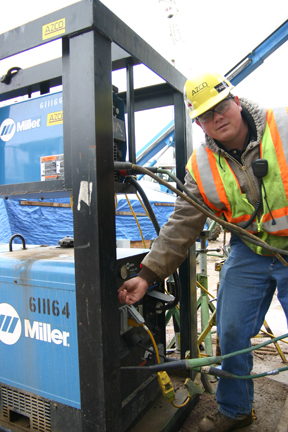 |
| Brandon Stoffregen, operating engineer, Local 49, maintains and fuels a PipePro 304. By pairing a PipePro 304 with an XMT 304, only nine PipePros need to be maintained—half of what would otherwise be required. |
However, AZCO’s biggest savings came from eliminating the need for nine additional engine drives. In fact, each skid saves the company $579 per month. Over the course of the nine-month Mankato project, nine skids saved AZCO a total of $46,899 (see Fig. 3 for details). The rental costs noted are AZCO’s inter-company rental costs, which are slightly lower than renting equipment on the open market (Lang’s tool/warehouse operation functions like a separate division, which enables AZCO to optimize asset management).
|
Mankato Savings on XMT 304/PipePro 304 Combinations
|
|
Monthly cost of renting two PipePro 304s
|
Monthly cost of renting PipePro 304/XMT 304 skid
|
Savings per skid/per month
|
Savings per month/9 skids
|
Savings for 9 month job
|
|
$1,476
|
$897
|
$579
|
$5,211
|
$46,899
|
Fig. 3
Purchase cost, rental cost, maintenance, fuel, transportation—all the savings add up quickly. But just as important is that the XMT 304, alone, in four-packs or in a pairing with a PipePro 304, allows Lang the versatility to quickly respond to changing job site requirements around the country, to keep his fleet and construction crews at work, and to meet the needs of the most demanding highly skilled operators in the industry.